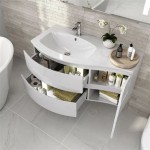How To Change a Bathroom Countertop: A Comprehensive Guide
Replacing a bathroom countertop can significantly enhance the aesthetic appeal and functionality of a bathroom. This project typically falls within the reach of a moderately skilled DIY enthusiast; however, careful planning, preparation, and execution are essential for a successful outcome. This article provides a detailed guide on how to remove an existing bathroom countertop and install a new one, covering necessary tools, materials, and step-by-step instructions.
Preparation and Planning: Assessing the Project
Before commencing any work, a thorough assessment of the existing countertop, plumbing, and surrounding cabinetry is crucial. This initial evaluation helps determine the scope of the project and identify potential challenges. The following steps outline the pre-installation assessment process:
1. Measurement and Material Selection: Accurately measure the length and width of the current countertop. Note the location of the sink and any other fixtures, such as faucets or soap dispensers, that will need cutouts. These measurements are vital for selecting the appropriate size and shape for the new countertop. When choosing the new countertop material, consider factors such as durability, aesthetics, budget, and ease of maintenance. Common countertop materials include laminate, solid surface (e.g., Corian), quartz, granite, and marble, each offering varying properties and price points. Obtain accurate measurements to minimize the need for on-site cutting, especially with materials like granite or quartz which require specialized equipment.
2. Plumbing and Electrical Considerations: Inspect the plumbing connections under the sink. Identify the shut-off valves for both hot and cold water. If these valves are old or corroded, they may need to be replaced to ensure a leak-proof seal when reconnecting the plumbing. Note the location of any electrical outlets or switches that may be affected by the countertop replacement. If electrical work is required, consulting a qualified electrician is strongly recommended. Disconnecting and reconnecting plumbing and electrical components improperly can lead to water damage or electrical hazards. Consider the plumbing fixtures that may need replacing at the same time, such as the faucet and drain assembly. This is an opportunity to upgrade these components and ensure a coordinated design.
3. Cabinetry Evaluation: Examine the condition of the cabinets beneath the countertop. Ensure they are structurally sound and level. If the cabinets are damaged or uneven, they may need to be repaired or replaced before installing the new countertop. The stability and levelness of the cabinets directly impact the support and appearance of the countertop. If the cabinets are not level, shims can be used to compensate for the variations. Address any cabinet issues before proceeding with the countertop installation to avoid future problems.
4. Tool and Material Acquisition: Compile a comprehensive list of all necessary tools and materials. Required tools typically include a utility knife, screwdriver set (both Phillips and flathead), adjustable wrench, pipe wrench, putty knife or scraper, level, measuring tape, safety glasses, gloves, and a drill with various bits. For cutting and shaping certain countertop materials, a circular saw, jigsaw, or router may be required. Materials include the new countertop, silicone caulk, shims, construction adhesive, and any necessary plumbing fittings or connectors. Purchasing all tools and materials in advance reduces delays and ensures a smooth installation process.
Removing the Existing Countertop: A Step-by-Step Guide
The removal process requires careful attention to avoid damaging the existing plumbing, cabinets, or surrounding walls. The following steps detail the procedure for safely removing the old countertop:
1. Shut Off Water Supply: Locate the shut-off valves under the sink and turn them clockwise to completely shut off the water supply to the faucet. If the valves are seized or do not function properly, the main water supply to the house may need to be temporarily shut off. After shutting off the water, turn on the faucet to relieve any residual pressure in the pipes. Place a bucket under the sink to catch any remaining water.
2. Disconnect Plumbing: Using an adjustable wrench, carefully disconnect the water supply lines from the faucet. It is advisable to place a towel or bucket underneath to collect any dripping water. Disconnect the drain assembly from the sink. This typically involves loosening slip nuts and disconnecting the P-trap. The P-trap may contain stagnant water and should be handled with caution. If the faucet is attached to the countertop, disconnect the supply lines and detach the faucet before removing the countertop.
3. Detach the Countertop: Examine how the existing countertop is attached to the cabinets. It may be secured with screws, adhesive, or a combination of both. If screws are present, use a screwdriver to remove them. If adhesive is used, a putty knife or scraper can be used to gently separate the countertop from the cabinets. Work slowly and carefully to avoid damaging the cabinets. In some cases, the countertop may be caulked to the wall. Use a utility knife to cut through the caulk along the back and sides of the countertop.
4. Remove the Countertop: With the plumbing disconnected and the countertop detached from the cabinets, carefully lift the countertop and remove it from the bathroom. Depending on the size and weight of the countertop, assistance may be required. Exercise caution to avoid dropping the countertop or damaging the surrounding walls and fixtures. Dispose of the old countertop according to local regulations.
5. Clean the Cabinet Surface: Once the old countertop is removed, thoroughly clean the surface of the cabinets. Remove any debris, adhesive residue, or caulk remnants. Ensure the surface is clean, dry, and level before installing the new countertop. This step is crucial for ensuring proper adhesion and support for the new countertop.
Installing the New Countertop: Ensuring a Secure and Level Fit
The installation process demands precision and attention to detail. Proper alignment and secure attachment are essential for a durable and aesthetically pleasing result. The following steps outline the installation procedure:
1. Dry Fit and Adjustments: Before applying any adhesive, perform a dry fit of the new countertop. Place the countertop on the cabinets and check for proper alignment. Ensure that the countertop sits flush against the wall and that there are no gaps or uneven areas. Use a level to check the countertop's levelness. If necessary, use shims to level the cabinets and countertop. Minor adjustments can be made at this stage to ensure a perfect fit. This pre-installation check is crucial for identifying and resolving any potential issues before committing to the final installation.
2. Apply Adhesive and Secure Countertop: Apply a thin bead of construction adhesive to the top edges of the cabinets where the countertop will rest. Carefully lift the countertop and place it onto the cabinets, aligning it according to the dry fit. Press firmly to ensure the adhesive makes good contact. If the countertop is designed to be screwed to the cabinets, pre-drill pilot holes through the cabinets and into the underside of the countertop. Use screws of appropriate length to secure the countertop, being careful not to overtighten them. Clamps can be used to hold the countertop in place while the adhesive dries. Follow the adhesive manufacturer's instructions for curing time.
3. Seal and Caulk: Once the adhesive has cured, apply a bead of silicone caulk along the back of the countertop where it meets the wall. Also, caulk around the edges of the sink cutout to create a watertight seal. Smooth the caulk with a wet finger or a caulk smoothing tool for a clean and professional finish. Allow the caulk to dry completely before reconnecting the plumbing.
4. Reconnect Plumbing: Reconnect the faucet and drain assembly to the sink, following the manufacturer's instructions. Connect the water supply lines to the faucet, ensuring that the connections are tight and leak-proof. Turn on the water supply slowly and check for leaks. If any leaks are detected, tighten the connections or replace the fittings as necessary. Allow the water to run for a few minutes to flush out any air or debris from the pipes.
5. Final Inspection and Cleanup: Conduct a final inspection of the installed countertop. Check for any gaps, uneven areas, or leaks. Clean up any debris or caulk residue. Ensure that all tools and materials are properly stored. The bathroom is now ready for use.
Replacing a bathroom countertop is a project that requires careful planning and execution. By following these detailed steps and taking necessary precautions, homeowners can successfully transform their bathrooms with a new and improved countertop.

Replace Vanity Top And Faucet Diy Network

Replace Granite Countertops Transform Your Bathroom S Look

Diy Vanity Tops For Your Bathroom

Paint Bathroom Vanity Countertop Sink So Easy A Piece Of Rainbow

Ways To Freshen Up Your Bathroom Countertop

How To Remove Replace A Vanity Top Easy Bathroom Sink Remodel

Diy Wood Bathroom Countertop An Easy Way To Change Your Vanity In 1 Weekend Noting Grace

Replace Vanity Top And Faucet Diy Network

Paint Bathroom Vanity Countertop Sink So Easy A Piece Of Rainbow

5 Easy Ways To Declutter Your Bathroom Countertop
Related Posts







